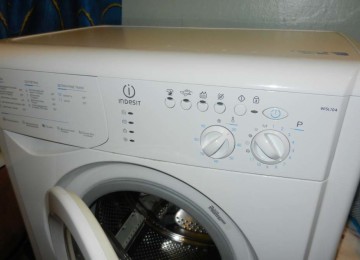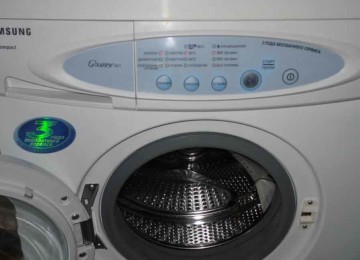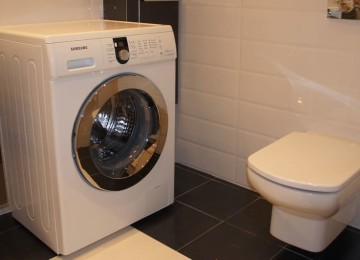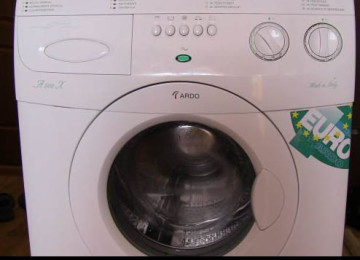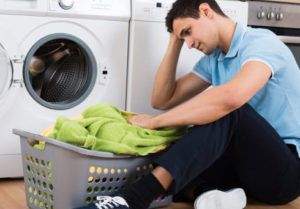 After the items are loaded into the washing machine, the program is selected and the “Start” button is pressed, the door of the device is locked and cannot be opened until the wash is completed. But there are situations when, after starting work, there is a need to urgently interrupt the process and open the door. You will learn further how to open the washing machine during washing so that it does not harm either the equipment or the interior.
After the items are loaded into the washing machine, the program is selected and the “Start” button is pressed, the door of the device is locked and cannot be opened until the wash is completed. But there are situations when, after starting work, there is a need to urgently interrupt the process and open the door. You will learn further how to open the washing machine during washing so that it does not harm either the equipment or the interior.
How to open the door using software settings
The algorithm of actions may vary slightly depending on the model and configuration of the washing machine, but experts recommend doing the following:

- First of all, you need to interrupt the washing program. Most models have a Pause button that allows you to temporarily stop the process. Sometimes it is separate, sometimes this function is performed by briefly pressing the “Start” button during operation. If such a function is not provided by the manufacturer, the machine can be de-energized by disconnecting it from the network. But this should be done only in extreme cases, since such actions can cause damage to electronic boards. Also, to stop the program in some models, you can return the washing mode selection knob to its original position.
- If there is already a lot of water in the drum, then before opening the door, you will need to drain it, otherwise the factory settings will not allow the lock mechanism to be unlocked. The amount of water that the door will open after the machine has stopped depends on the parameters set by the manufacturer, and not only the amount of water, but also its temperature can be taken into account. Sometimes it is enough for the water level not to reach the bottom edge of the door. It also happens that the lock is removed regardless of how much water is inside, it is enough to simply de-energize the device. Therefore, after the machine has stopped, you should wait a few minutes and make sure that the lock is unlocked. If the water in the tank still does not allow you to open the door or there is too much of it, you need to get rid of it. The easiest way is to use a special function, which is usually called "Drain". After the water has drained from the drum, opening the door is easy. If the design does not include a "Drain" button, you can use the "Spin" function.
Sometimes situations arise when it is not possible to drain the water using the program buttons for some reason, and it is not advisable to start the spin - for example, if a mobile phone gets into the machine, the machine's operation in spin mode with this device inside can damage both devices.
It also happens that the programs do not function due to a breakdown of the automatics or a power outage.If not much time has passed since the start of the wash, and water has not had time to fill the tank, perhaps this will be enough - after a few minutes the door will unlock and it can be opened.
If there is already a lot of water in the drum, then before opening the door, it will need to be drained, otherwise the factory settings will not allow you to unlock the lock mechanism. At what amount of water the door will open after stopping the machine depends on the parameters specified by the manufacturer, and not only the amount of water, but also its temperature can be taken into account. Sometimes it is enough that the water level does not reach the bottom edge of the door. It also happens that the blockage is removed regardless of how much water is inside; it is enough to simply turn off the power to the device. Therefore, after the machine has been stopped, you should wait a few minutes and make sure that the lock is unlocked. If the water in the tank still prevents you from opening the door or there is too much water, you need to get rid of it. The easiest way is to use a special function, which is usually called “Drain”.
Once the water has drained from the drum, opening the door will not be difficult. If the “Drain” button is not provided in the design, you can use the “Spin” function.
How to drain water manually

Sometimes situations arise when for some reason it is not possible to drain the water using the program buttons, and starting the spin cycle is impractical - for example, if a mobile phone gets into the machine, operating the machine in spin mode with this device inside can damage both devices.
Drain pipe
On the front of any washing machine in the lower right corner there is a removable panel that hides the drain tube. In normal condition, this tube is equipped with a plug.
In order to drain the water manually, you need to remove the plug and lower the tube into a previously prepared container where the water will go. Sometimes the tube is missing, but the plug will be there in any case.

Since it is not possible to direct water into a separate container when removing the plug, measures must be taken to ensure that the spilled liquid causes as little damage as possible. After the water has been drained and the cause of the panic has been removed from the drum, the washing settings will have to be set again.
Drain hose
Every washing machine includes a drain hose. You can most often find it on the back of the unit, but sometimes manufacturers place it at the bottom.
The hose is disconnected from the machine and lowered into a container into which it will be drained. For water to start pouring out, the end of the hose must be below the water level in the tank, otherwise, according to the law of communicating vessels, water will not be able to leave the machine.
Pipe branch
This method is the most difficult for non-professionals. Sometimes water does not leave the machine because the pipe is clogged. To fix this problem, you need to turn off the power to the machine, pull out the pipe that is located at the bottom of the machine, and clean it of debris.
Emergency opening
After the water leaves the tank, the automatic door lock is released. However, in the case of manual draining, it happens that the water has not completely drained and the water control sensor does not allow the lock to be opened.
It also happens that due to a failure in the software settings, the lock gets stuck and the door cannot be opened even if there is no longer any water in the drum. Sometimes the cause is a mechanical failure of the latch.
Manufacturers have provided such options, so you can deal with a stubborn lock yourself, without the help of service workers. You can read about them and the required algorithm of actions in the instructions for the device.

But before using these methods, the machine must be unplugged. If it was not possible to drain the water first, you need to make sure that a huge puddle does not form on the floor after the emergency measures taken.
Emergency opening rope
Usually this cable is made in a contrasting color, red or orange, so it is impossible not to notice it. To outwit the lock, you need to pull it smoothly, without jerking.
Opening with a cord
If there is no cable in the washing mashine, but you have a thin synthetic cord or strong fishing line at hand, you can try to open the washing mashine with their help. This method is a folk one, so the possibility of its use depends on the design of the lock.
This method of breaking the lock will only work if the lock tongue snaps towards the body of the machine. If the tongue is directed in the other direction - away from the body or up - it will not be possible to open the door using the cord.
It’s unlikely that you’ll be able to understand exactly how the lock works when the door is closed, but if you don’t have time to wait for the locksmith and other methods don’t help, you can try this one. You will need to put the cord around the edges of the hatch around the entire perimeter and pull its ends up, as a result of which the cord will compress the latch and allow you to open the door.
If you don’t have a cord at hand, but have a thin flexible spatula, you can use it. The principle of operation is the same as when opening the door with a cord. The end of the spatula must be inserted into the gap between the hatch and the washing mashine body and, pressing it, try to open the door.
Removing the panel
This method is practically fail-safe, but requires certain technical skills, tools and physical strength. In addition, to use it, you must drain the water from the unit by any available method. After there is no liquid left in the drum, the machine is disconnected from the network and the top cover is unscrewed.
In rare cases, the bolts can be removed using a standard screwdriver, but most often manufacturers secure the parts with special bolts, and to unscrew them you need to use TORX keys. The difficulty lies in the fact that even the presence of a key of the required model does not guarantee the ability to remove the bolts - their size may not fit the key model. Most often, manufacturers use the T15, T20 and T25 options.






